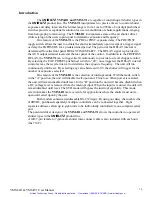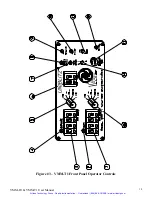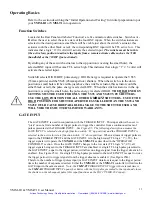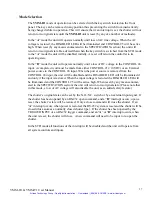
Initial Operation and Testing
The
VMM-D1
and
VMM-T1
will operate from 115VAC or 230VAC (50-60Hz), this
is manually selectable. *
PLEASE BE SURE THAT THE UNIT IS PROPERLY SET UP
FOR THE LINE VOLTAGE TO BE USED.*
Once the line cord has been attached to unit
and connected to properly grounded wall receptacle, the unit may be operated.
*BE SURE
POWER SWITCH IS IN THE OFF POSITION BEFORE CONNECTING PLUG TO
LINE. ATTACH LINE CORD TO THE UNIT FIRST BEFORE PLUGGING INTO
THE AC POWER SOURCE.*
See “
Start Up
” section.
Insert the seven pin male connector of shutter interconnect cable into seven pin female
receptacle at rear of unit labeled SHUTTER. Connect the seven pin female connector of shutter
interconnect cable to seven pin male connector on shutter to be driven.
Place POWER switch to the ON “1” position, the POWER LED will illuminate. Place
the N.O./N.C. switch into the N.O. position. The shutter will open and remain open until the
switch is returned to the N.C. position. The SHUTTER ACTIVE LED will illuminate when
this switch is in the N.O. position.
All
UNIBLITZ
drivers provide the circuitry necessary to support shutters equipped with
the solid state synchronization option. Simply plug the shutter interconnect cable into the
driver. If your shutter is equipped with this option the green LED, labeled SYNC ACTIVE,
will illuminate when the shutter is in the open position. In addition, the active low SYNC
output will change to the low state when the shutter is open. The absence of the solid state
synchronization option will only inhibit the operation of the SYNC output and SYNC ACTIVE
LED. The remainder of the
VMM-D1
and
VMM-T1
systems will not be affected.
See specifications and operator controls for additional operational information
concerning other systems of the
VMM-D1
and
VMM-T1
CAUTION
Should the shutter and/or control not respond as described previously, be sure line cord is installed into
the receptacle and connections to the shutter are made properly. Note that the shutter output is also fused (located
at the front panel - .6A time-lag).
TURN OFF THE UNIT AND REMOVE THE PLUG FROM THE AC
SOURCE BEFORE CHECKING FOR BLOWN FUSES
. Be advised, a visual inspection of a fuse is usually
NOT
an adequate test to determine if a fuse failure has occurred. Use a DMM (Digital Multi-Meter) or equivalent
test device to determine fuse continuity. Also, particular shutter units respond to different minimum pulse widths.
For example, a standard VS25 shutter has a minimum exposure pulse of 6ms, if the timing is set for an exposure
pulse width less than 6ms, the shutter may not open fully. If the unit still does not operate properly, please notify
Vincent Associates immediately.
VMM-D1 & VMM-T1 User Manual
13
Artisan Technology Group - Quality Instrumentation ... Guaranteed | (888) 88-SOURCE | www.artisantg.com















































